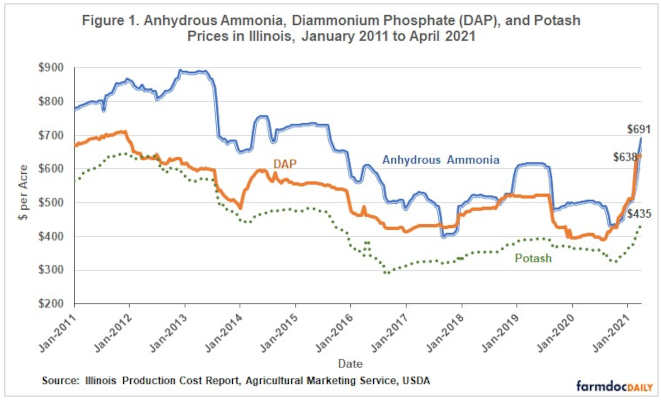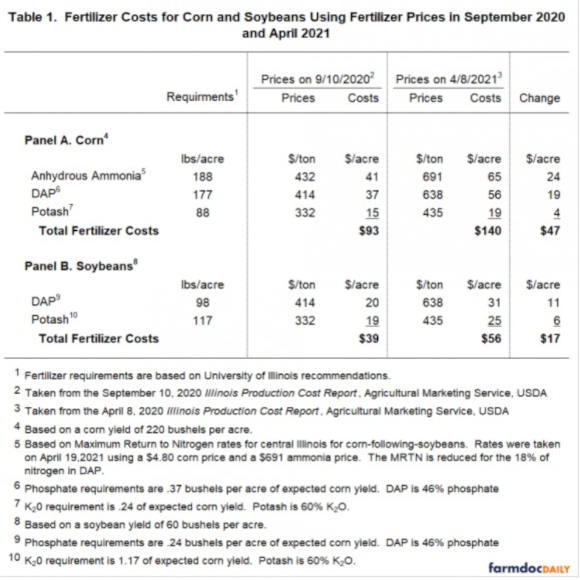
From September 10, 2020, to April 8, 2021, AMS reported an increase in Diammonium Phosphate (DAP) from $414 per ton to $638 per ton, an increase of $224 per ton, or 54%. DAP prices are now at their highest level since December 2011 (see Figure 1). As 46% of its weight is phosphate, DAP is used by many Illinois farmers to provide phosphate requirements. Eighteen percent of DAP’s weight is in nitrogen, thereby also providing nitrogen.
Potash, used mainly to provide potassium, increased in price from $332 per ton in September 10, 2020 to $435 per ton on April 8, 2021, an increase of $103 per ton, or 31%. Potash prices are now the highest they have been since September 2015.
Impacts on Corn and Soybean Fertilizer Costs
Timing of fertilizer purchase for the 2021 crop will significantly impact total fertilizer costs, as illustrated in Table 1. Table 1 shows the calculation of per acre fertilizer costs for corn and soybeans grown in central Illinois using fertilizer prices on September 9, 2020, and April 8, 2021. Fertilizer requirements are derived from University of Illinois recommendations.

DAP and potash application levels shown in Table 1 are based on average removal rates for corn and soybeans (see Nafziger, farmdoc, September 7, 2017). Expected yields are 220 bushels per acre for corn and 60 bushels per acre for soybeans (see footnotes on Table 1 for calculations of requirements). The nitrogen application rate for corn is based on the Maximum Return to Nitrogen (MRTN) rate as calculated on a website maintained by seven Midwest Land Grant Universities (here). The MRTN rate was obtained on April 19, 2020, using a corn price of $4.80 per bushel and an anhydrous ammonia price of $691 per ton for corn-after-soybeans grown in central Illinois. Anhydrous ammonia requirements account for a reduction in the MRTN rate to account for the 18% of DAP that is nitrogen. A full credit for the nitrogen in DAP is taken under the assumption that DAP was applied after November 1 when the ground was cool (Nafziger, farmdoc daily, March 29, 2019).
Using September 2020 prices, fertilizer costs for corn are estimated at $93 per acre (see Table 1). Those costs increase to $140 per acre using April 8, 2021 fertilizer prices, an increase of $47 per acre or 51%. Fertilizer costs for soybeans increase from $39 per acre using September 10, 2020 prices to $56 per acre using April 8, 2021 prices, an increase of $17 per acre or 44%.
Fertilizer costs increased more for corn than soybeans. As shown in Table 1, corn fertilizer costs increase $47 per acre (from $93 to $140 per acre) while soybean fertilizer costs increased $17 per acre (from $39 per acre to $56 per acre). The larger increase for corn is mostly due to the fact that corn uses nitrogen fertilizer while soybeans do not. An increase in anhydrous ammonia price accounts for $24 per acre of the fertilizer cost increase in corn (from $41 per acre using September 10, 2020 prices to $65 per acre using April 8, 2021 prices).
Summary and Implications
Fertilizer prices have increased a great deal since the fall of 2020. These large price increases have corresponded to corn and soybean price increases. Increased fertilizer costs will offset some of the additional profitability that may result from corn and soybean production if higher prices persist into the Fall of this year and winter of next year. Input Prices have a history of increasing with corn prices (see farmdoc daily, September 15, 2015, June 14, 2016). As a result, the current price increases are not unexpected. Given historical relationships, one would not expect nitrogen and other fertilizer prices to decline until corn and soybeans prices decline, likely in a lagged relationship.
The timing of fertilizer purchases will have a large impact on fertilizer costs associated with 2021 production. Those farmers who purchased and applied most of their fertilizers in fall 2020 will likely have lower costs than those applying and purchasing most of their inputs in spring 2021. For example, many farmers apply phosphate and potash fertilizers in the Fall. Those farmers will have lower costs than those farmers who purchase and apply those fertilizers in the spring for the 2021 crop. Some farmers apply all or a majority of their nitrogen fertilizer in the late Fall. Fall-applied fertilizer likely will have lower costs than nitrogen applied in the spring and summer for the 2021 crop.
Fertilizer costs have increased more for corn than for soybeans. Overall, this will increase the profitability of soybeans relative to corn. Soybeans have been projected more profitable than corn so the additional fertilizer costs may not influence acreage decisions (see farmdoc daily, October 27, 2020).
Source : illinois.edu